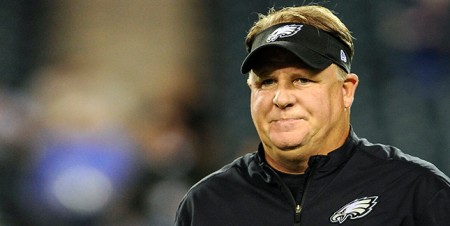[LevelEleven is all about optimizing performance with motivation, competition, collaboration and recognition, which is partially why we’re really pumped up for football season! Today, enjoy the first of 3 football-related sales optimization articles — and keep an eye out for the others!]
Sales Leaders Can Learn From Chip Kelly About Motivating a Winner with Visibility
“Little things make the difference. Everyone is well prepared in the big things, but only the winners perfect the little things.” -Legendary Football Coach, Bear Bryant
It makes sense that we look to learn from the games that have become engrained in our culture, because underneath the raw athleticism on the field, they demonstrate winning principles in action — from traits like sportsmanship and humility to the game-changing impact data analysis and analytics can have on decision making and building a winning team or company. And there are often great lessons in seemingly unsuspecting places, which is why sales leaders should take a good look at a recent ESPN article featuring Chip Kelly, head coach of the NFL’s Philadelphia Eagles.

The article offers insight into Kelly, a famously innovative and forward thinking football coach, and how he approaches building a winning culture and motivating his players to perform at the top level — which is something all sales leaders are looking to achieve in their own teams — by really leveraging visibility, competition and recognition for the behaviors crucial to his operation and its success.
Kelly faced a major challenge in taking over head coaching duties before the 2013 season, essentially having to onboard his team into his own new and demanding system — one that emphasizes mastering the details that lead to winning games long before stepping foot onto the field for game day and continuing consistently to meet the incredibly demanding threshold of winning in the NFL.
How Added Visibility is a Game Changer
One of Kelly’s primary strategies is to field a team that’s in superior physical condition to its opponents, creating a competitive advantage his team can leverage. Ultimately, superior conditioning helps them achieve the greater goal of winning games — but in an environment where players are inundated with a range of demands, actually focusing the behaviors that will improve the team’s conditioning is a motivational challenge in itself.
The article describes two unique and interesting behaviors Kelly focuses his team around to help meet their conditioning goals — optimizing player hydration levels and sleeping habits. And it’s not just lip service. Kelly puts significant emphasis on these, so much so that he literally tracks data by testing each player’s hydration levels after practice, as well as having them wear bracelets that track and monitor sleep (encouraging a lofty 10-12 hours per night). In order to really drive focus and awareness around these behaviors, he collects the data and displays it on a screen in the team’s practice facility so players can see exactly where they stand against their peers, as well as their own personal performance. Or, as it says in the article, “drinking water is now a game.”
What seems at the outset like relatively insignificant behaviors are key to achieving the larger vision — and for sales leaders, this is where the rubber meets the road.
Because, like a great sales leader, Kelly understands that improving performance doesn’t happen by simply wanting or asking for it — it comes from mastering the behaviors that breed success. As a result, innovative sales leaders aren’t just looking to motivate their teams to close more sales, they’re motivating the behaviors that help result in more sales, like contacting opportunities, improving training and onboarding, aligning marketing and sales initiatives, improving CRM adoption — even behaviors that benefit team morale and culture because they ultimately impact a business’ bottom line.
And the real benefit, as we’ve seen, is that approaching motivation with the focus of improving visibility isn’t just for short term gains — people’s habits change, and the effect maintains over time.
Key Factors for Impactful Motivation
As demonstrated in Kelly’s approach, here’s a breakdown of key factors for motivation:
- Identifying key behaviors (i.e. Improved hydration and sleep will benefit conditioning, which will improve the chances of winning games)
- Drive key behaviors with increased visibility and competition (i.e. Tracking sleep and hydration metrics improves focus and visibility, while the leaderboard encourages performance with competition)
- Track performance metrics to gauge progress (i.e. Collecting data on key behaviors and tracking development)
- Recognize top performers (i.e. Performing well results in rising up the leaderboard, which provokes natural peer-to-peer recognition)
- Analyze the overall impact (i.e. Determining whether the behaviors result in a better outcome. Why or why not? What other behaviors might need attention?)
It Boils Down to the Little Things
Winning in sales, like football, doesn’t happen just when you go to pitch a buyer or take the field for a game. You win or lose as a result of the actions that lead up to those moments and whether or not you were successful in motivating winning behaviors along the way.
Everyone wants to close more sales and drive more revenue — but what winning teams have in common is a commitment to the behaviors that lead to those outcomes and mastering them by adding visibility and focus to motivate the best possible outcomes.
So in other words, for achieving the big things, it’s focusing on the little one that makes all the difference.
[starbox]



